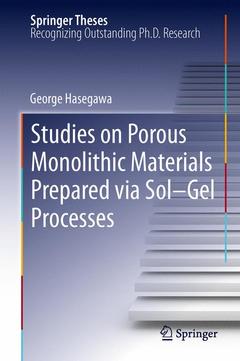Studies on Porous Monolithic Materials Prepared via Sol-Gel Processes, 2013 Springer Theses Series
Auteur : Hasegawa George

From the Contents: General Introduction.- Pore Formation in Poly(divinylbenzene) Networks Derived from Organotellurium-Mediated Living Radical Polymerization.- Extension of Living Radical Polymerization Accompanied by Phase Separation to Methacrylate- and Acrylamide-based Polymer Monoliths.- Novel Monolithic Capillary Column with Well-Defined Macropores Based on Poly(styrene-co-divinylbenzene).- Fabrication of Activated Carbon Monoliths with Well-defined Macropores Derived from Sulfonated Poly(divinylbenzene) Networks.- Monolithic Electrode for Electric Double-Layer Capacitors Based on Macro/Meso/Microporous S-Containing Activated Carbon with High Surface Area.- Facile Preparation of Transparent Monolithic TiO2 Gels Utilizing Chelating Ligand and Mineral Salts.- Novel and Facile Preparation of Hierarchically Porous TiO2 Monoliths.- Application of Hierarchically Porous Titania Monoliths to Chromatographic Separation Media.- Arylene-bridged Polysilsesquioxane Monoliths with Multi-Scale Porous Structure Prepared via Sol–Gel Process Followed by Hydrothermal Treatment.- Fabrication of Macroporous SiC and SiC/C Monoliths from Arylene-Bridged Polysilsesquioxanes via Carbothermal Reduction.-Hierarchically Porous Carbon Monoliths with High Surface Area from Arylene-Bridged Polysilsesquioxanes without Thermal Activation Process-. Facile Preparation of Monolithic LiFePO4/Carbon Composites with Well-Defined Macropores for Li-ion Battery.- General Summary.
Department of Energy and Hydrocarbon Chemistry,
Graduate School of Engineering, Kyoto University
Was named best-in-department thesis (Chemistry, 2012) from the Graduate School of Science, Kyoto University
Presents state-of-the-art porous monoliths based on various chemical compositions (organic, inorganic, and organic–inorganic hybrid materials) fabricated via the sol–gel method accompanied by phase separation
Includes many electron micrographs, helping general readers to understand the pore structures of the materials
Date de parution : 11-2014
Ouvrage de 208 p.
15.5x23.5 cm
Disponible chez l'éditeur (délai d'approvisionnement : 15 jours).
Prix indicatif 105,49 €
Ajouter au panierDate de parution : 10-2012
Ouvrage de 208 p.
15.5x23.5 cm
Disponible chez l'éditeur (délai d'approvisionnement : 15 jours).
Prix indicatif 105,49 €
Ajouter au panier


